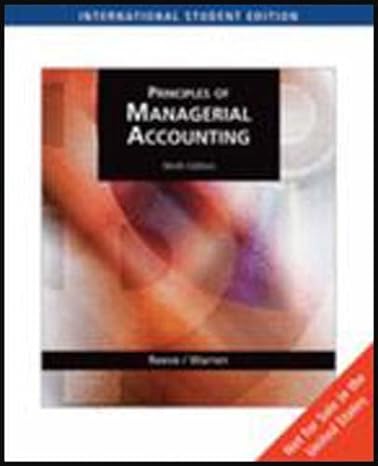Question
Namib Mills makes use of sugarcane to manufacture Marathon Sugar, Paper Pulp and Molasses. Molasses is the only by-product obtained in the preparation of sugar
Namib Mills makes use of sugarcane to manufacture Marathon Sugar, Paper Pulp and Molasses. Molasses is the only by-product obtained in the preparation of sugar through repeated crystallisation, the yield of molasses per tonne of sugarcane is 5%. Molasses is sold at N$5 per kg and the cost of repeated crystallisation is N$0.50 per kg.
The company harvest a total of 9 tonnes of sugarcane in the current year, the company harvests the exact amount of sugarcane planted. The amount of sugar extracted from a single tonne of sugarcane amounts to 600kg and 350kg of paper pulp. The initial process of manufacturing commences with the planting of cane setts (raw material) on the ground which costs N$11 111 per tonne. The next step involves fertilising the ground to make it conducive for production at a cost of N$1 389 per bag enough to cover a single tonne cane setts. The company spend a total of N$54 000 on irrigation of the plantation. Workers are involved in the plantation and harvesting of the sugarcane, throughout the entire process. Labourers are paid at a rate of N$107.5 per hour and the total numbers of hours worked in the year was 800 hours in total. A harvesting machine used during the harvesting season is rented for an amount N$45 000 for the whole year. Sugar produced from the sugarcane is sold for N$50 per kg and the paper pulp is sold for N$40 per kg. After harvesting, the sugar has to go through a milling process before it is ready to be sold. The milling process costs N$20 000 in total for the year. In order for the pulp from the sugarcane to be turned into paper pulp, it has to be mixed with bleach and chemicals before it becomes a finished paper pulp product. The bleach and chemicals used for the year on the paper pulp amounted to N$15 000 in total. Namib Mills reduces the joint costs by the net realizable value of the by-product.
Explain the physical units and the sales at split off methods of allocating joints 2 3.2 Explain the reason why we allocate joint costs 2 3.3 Calculate the total joint costs to be allocated 8 3.3 Allocate the joint costs using the Net Realizable Method 8 3.2 Allocate the joint costs using the Constant Gross Profit Percentage Method 6 TOTAL MARKS 26
Step by Step Solution
There are 3 Steps involved in it
Step: 1

Get Instant Access to Expert-Tailored Solutions
See step-by-step solutions with expert insights and AI powered tools for academic success
Step: 2

Step: 3

Ace Your Homework with AI
Get the answers you need in no time with our AI-driven, step-by-step assistance
Get Started


